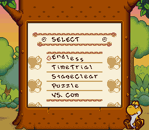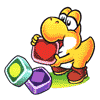"Now let's go play, together...
Together under the clearest of blue skies." ― BS Yoshi no Panepon/Tetris Attack Nintendo Screen
Yoshi no Panepon, also known as Tetris Attack outside of Japan, is a reskin of the original Panel de Pon. This is the 1st Panel de Pon game in the series to be released in most regions, while in Japan this is the 2nd game in the Panepon series under the Panepon name. The characters were changed to be from the Yoshi series. The stages and artwork were all changed to remove any Panel de Pon references. The music in the game is identical to the original Panel de Pon, with a few exceptions and the introduction of a few Yoshi-themed tracks, some originally composed by Koji Kondo. This game has led to future rebrandings of the Panel de Pon series, in an attempt to make the series more marketable for a worldwide audience. This game is also quite infamous for not getting a re-release for the Virtual Console since the original Panel de Pon has always been released regularly on Nintendo's Virtual Console service in Japan along with being included on the SFC Mini.
The game was originally released in the west as a replacement for the original Panel de Pon and then later brought to Japan using the Satellaview.
Differences from Panel de Pon[]
- In the menu, there's an additional option that allows players to view content such as the sound effects, character bios and change some of the settings for the 2-player vs. mode.
- The title screen is entirely redesigned with no assets used from Panel de Pon.
- The game states that the Tetris name was licensed with permission for Nintendo to use. This change is not in the Japanese Satellaview version of the game, and instead the advertises the Game Boy version of the game.
- There's a Password screen for the Vs. mode.
Stage Differences[]
- The Fairy World was entirely redesigned to a Yoshi stage. Lip's theme only plays in the tutorial mode, since the game uses a rendition of Yoshi's theme.
- Garbage blocks are no longer unique to the character but instead, all characters use a modified version of Thanatos' Garbage Block.
- No mouth flaps whenever the characters do a chain in the 1-player modes.
- The voice that says "Nintendo" when you boot up the game is different.
- The Jewel World stage was entirely redesigned since Flying Wiggler is more associated with Flowers than Jewels.
- The first 3 bosses in Mt. Wickedness use a tileset like the ones seen in the Hub World.
- Kamek uses the theme of the Phoenix & Dragon.
- Bowser reuses Thanatos theme and the tileset is based off of the Dragon, making Cordelia's theme unused.
Vs. Mode Hub differences[]
- Colors are more saturated than Panel de Pon.
- Death Mt. was renamed to Mt. Wickedness.
- Kamek does not have a cutscene like Thanatos. (Stage 11)
- The palette does not change in the Bowser cutscene, nor are there any effects in place of the effects in Cordelia's cutscene.
- The ending is different, more similar to a typical Mario story.
Characters[]
Pals[]
Rivals[]
Videos[]
Yoshi no Panepon (ヨッシーのパネポン, Yoshi no Panepon) also known as Tetris Attack outside of Japan is essentially a watered-down port of its 16-bit counterpart of the same name. This is the 2nd Panel de Pon game in the series to be released in most regions, while in Japan this is the 1st game in the Panepon series under the Panepon name.
Differences from SNES/SFC BS version[]
- This game does not have smooth swapping or falling for the Panels.
- This game is missing the Upside down Triangle Panel regardless if you make it to level 9 or 10 (or go into Hard mode) in the 1-player mode
- Bumpty (Sherbet's counterpart) is missing in the game, making the vs. mode 1 stage shorter, and 1 less playable character overall.
- Only player 1's Panel is seen in the vs. mode.
- The computers in the vs. mode uses a health bar and a power meter.
- Panels are 15x15 pixels and displayed to the left and due to the smaller screen size; the game can only go 9 panels vertically as opposed to the usual 12.
- There is no language option in the game, meaning that the other region cannot use Japanese text in the English version and vice-versa.
- Characters are displayed at the right of the screen instead of the center.
- There are no backgrounds behind the panels.
- In the extra puzzle mode, enemy characters and those only playable in the vs. mode are used instead.
- This game graphically has been rebuilt to further differentiate itself from Panel de Pon.
- Garbage Block is now character dependent just like instead of reusing a modified version of Thanatos' Garbage block which was player color dependent.
Music[]
- Bowser's theme uses a new track instead of reusing Thanatos' Theme.
- Froggy's Pinch Theme is a bit shorter, which makes the song loop earlier.
Some of the tracks are used in Panel De Pon (GCN) theme in Panel De Pon (GCN).
- Gargantua Blargg's pinch theme is a bit shorter, later used for Rayea's
- The credits has a portion of Yoshi's Theme, later used for the GC release of Nintendo Puzzle Collection compilation of Panel de Pon.
Super Game Boy Borders[]
There are six Super Game Boy borders to choose from via button codes at the title screen, when selecting "1P" to play the game. The borders are based on the non-Vs. mode Stages:
Gallery[]
Videos[]
External Links[]
Yoshi no Panepon 3DS VC Page
Yoshi no Panepon Website
Trivia[]
- Due to licensing issues with the Tetris name, this game has not been re-released worldwide since.
- However, as the game did not utilize the Tetris name in Japanese territories, the game was able to be released for the Game Boy Virtual Console on the 3DS in those regions without issue.
- Henk Rogers regrets giving Nintendo permission to use the Tetris name, as he felt that the game should stand on its own.
[]
| Games in Panel de Pon series | |
|---|---|
| Games | Panel de Pon (Event • Yoshi) • GB (Pokémon) • 64 / Nintendo Puzzle Collection (Pokémon) GBA (Multiboot) • DS/Chotto (DSiWare) |
| Other | Nintendo Puzzle Collection • Super Smash Bros. Series • Captain Rainbow Animal Crossing: New Leaf - Welcome Amiibo |
















